Disclosure: Meeple Mountain received a free copy of this product in exchange for an honest, unbiased review. This review is not intended to be an endorsement.
“So…what did you think?”
Along with three members of my review crew, we had just wrapped up our first four-player game of Asian Tigers: A Story of Prosperity (2024, published by PYTHAGORAS and distributed in the US by Mayfair Games). There was a very long pause before anyone answered my question. I always ask other players for their opinion first before launching into my thoughts.
The opinions ranged wildly. One player loved it, another was still processing the rules load even at the end of our game, for reasons that we’ll come to during a discussion about the game’s scoring elements. The guy who won this first play was most conflicted of all. Winner’s bias is real, we all agreed, so he was in the best position to say whether he loved it or not.
“I really like this one,” he started. “There’s a lot to process with the rules, but ultimately I focused on the area control elements, and that worked out. I just don’t know how often I could see myself getting this to the table.”
This review of Asian Tigers: A Story of Prosperity has proven to be the toughest review I have written this year, in terms of determining a final score. For almost every element of the game that I liked, there are elements that absolutely didn’t work for me. Now that I’ve shown the game to four other unique players, I think the masses will see similar things during their experiences with the game.
If you’re a fan of medium-weight area control games, you should definitely try Asian Tigers: A Story of Prosperity. That’s especially true if you run in circles where someone else buys the game then learns the rules…because the rulebook and final scoring are the game’s biggest hurdles.
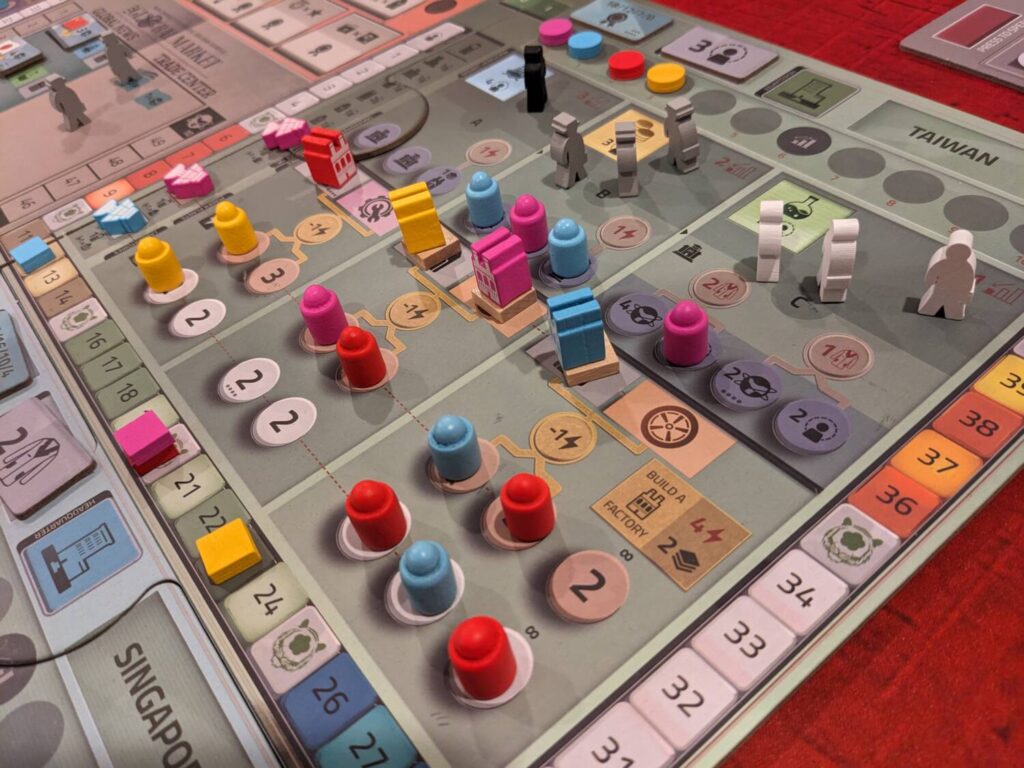
You Read the Rulebook How Many Times?
Asian Tigers: A Story of Prosperity is a 1-4 player worker placement game that ultimately plays as an area control game. Like many other area control games in my collection, the best strategy is to be competitive in every region of the game’s map…finishing first or second in each of the game’s regions has proven to be the key to victory in my three review plays, even when factoring in other ways to score points.
Of course, there are a million other considerations to talk through first…the biggest of which is the game’s rulebook. Asian Tigers has the most challenging, densely-written rulebook I have read this year. Between the weight of games I normally cover and the sheer breadth of other games I’ve reviewed in 2024, this was a surprising yet easy assessment to make.
Two things are at play here: for the first time maybe in my entire personal gaming history, Asian Tigers uses examples that are too detailed in the rulebook. How many pictured examples of a scoring mechanic have you read where there were TWENTY-SIX items detailed in the captions? In one case, the level of detail required to explain how a particular scoring element worked used all 26 letters of the alphabet, literally from A-Z. (If a scoring mechanic is this hard to translate, that scoring mechanic is too complex, right?)
I had to read this rulebook eight times before feeling good about teaching it to other players. After those eight reads, I still needed to do a full two-player dummy play before showing Asian Tigers to my review crew. And even during that game, I needed to regularly reference the rules to ensure I had everything right.
(While I had the pleasure of trying Asian Tigers before many of our peers in the content creation space, that also meant that there were no teach videos available at the time I got my plays in.)
The second issue with the rulebook—I don’t know who handled the localization of an English rulebook, but it’s clear that this “someone” is not a native English speaker. Everything you’ll need is in the rulebook, but it is not a smooth read, not in the slightest. After drafting this article, I went to the forums on BGG to see if others are experiencing similar issues…and I can confirm the game’s rulebook is not feeling the love from other parties as well.
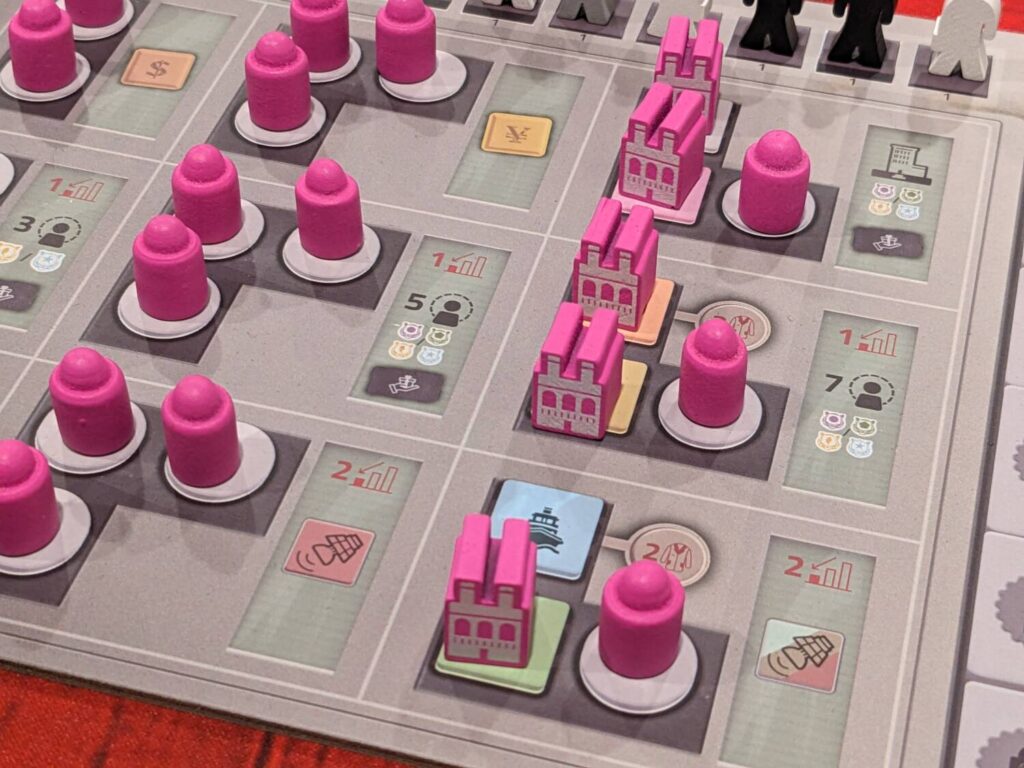
This next item probably won’t shock you, either—there’s no player aid. The back of the manual does have the iconography, but passing that amongst four players in a game with relatively quick turns meant the manual has already been handled dozens of times thanks to the tricky series of icons.
So, the “on ramp” for Asian Tigers is really, really bumpy. This level of fiddliness continues with a production that has run the gamut with players. The board is a drab-looking spreadsheet that features a breakout of the four “Asian Tigers”—South Korea, Singapore, Taiwan, and Hong Kong. At the center of the board is a global market that tracks where players can later sell goods to other countries, along with a score track that is used to determine turn order as well as an end-game multiplier that rewards moving high up that track along with selling goods to a large variety of different countries.
But the board itself is not a fancy, one-piece tri-fold board…it’s a six-piece jigsaw puzzle that is assembled based on player count. And that board doesn’t sit flat on the table. One player in that first four-player game spent the majority of his playtime trying to get one area of the map to flatten…sadly, he didn’t win that personal in-game challenge.
The color palette on the board is drab, and one player thought it was ugly as all-get-out. I was fine with the board’s palette; it won’t surprise you that I also loved the board from the Board&Dice game Tiletum. I loved how that somewhat-ugly base made the overall game look by the end of each play as the colorful player pieces populate each portion of the board. It was a nice contrast, even though the sheer number of pieces on the board are admittedly messy by the 20th and final round of the game.
The real issues for our players were tied to seeing all the necessary symbols on the board, particularly the cost of actions on the top half of the board…seeing a dark red font against a dark purple background was just a strange design choice, and it led to some players not being able to see the numbers printed on the board from across the table.
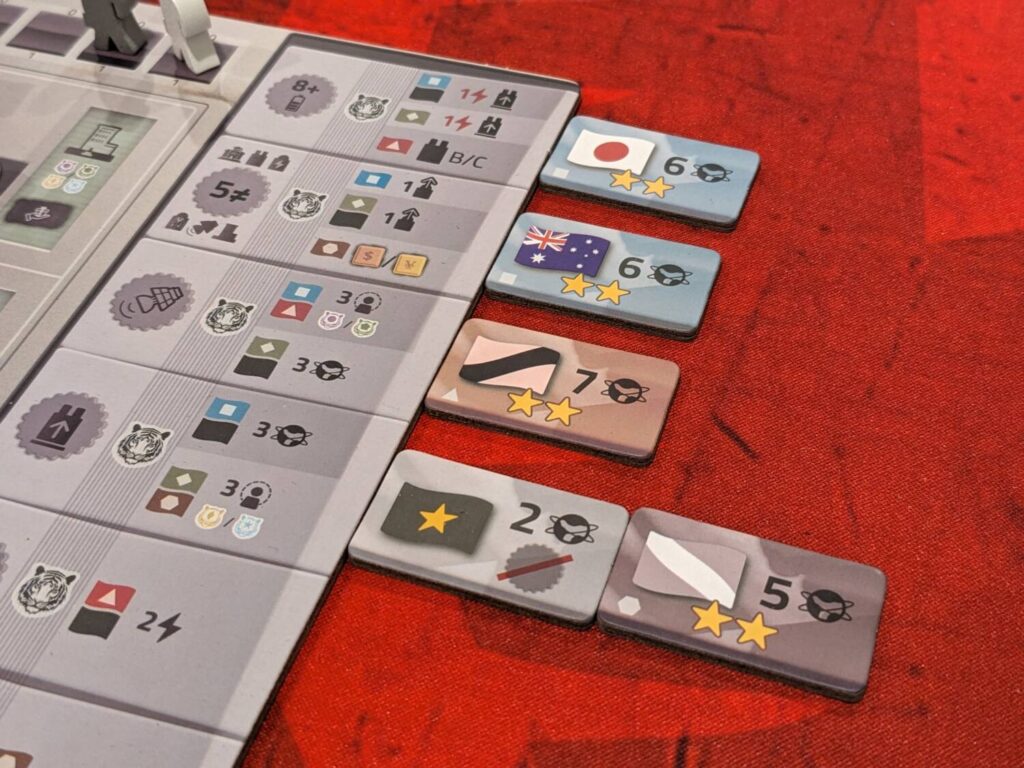
Then, Something Happens
The production of Asian Tigers, particularly the rules and the game board, is a miss. Then the game starts, and something happens—the gameplay is mostly excellent.
In Asian Tigers, it’s the 1960s, and players are industrial entrepreneurs who must spend investment funds (cleverly disguised in an action points system) to gain influence with each Tiger to build a variety of different infrastructures for their respective region, as well as produce goods that will later be sold to other global superpowers. The theme doesn’t really come out during the game, but it did lead to great table talk about Asia and the business environment 60-70 years ago, something I can’t remember doing in a board game setting in some time, if ever.
The highlight of the design is the worker placement system. Workers come in three flavors: gray, black, and white. Each player has a pool of 12 workers, four in each color, to use in each of the game’s two “Eras” (rounds). Only 10 of those 12 workers will actually be selected for use in a round, thanks to a random draw done by each player prior to each Era.
Each Tiger is broken into three regions—A, B, and C—and each region has a general area to place workers, as well as a section below the worker placement area to place generic infrastructure buildings. These buildings are small pegs that rest on a player’s personal board, and as they are used to become power plants, labs, universities, and other buildings, they slowly uncover immediate bonus actions that can lead to some very satisfying, combo-rich turns.

Once a player seeds a region’s worker placement area with a worker color, that region only accepts that same color worker for future turns taken using the same action area. So, if Kev places a gray worker in the A region of Singapore, that region is locked to only accept gray workers. Each Tiger accommodates all three colors of worker, but each region can only accept one color…so in every round, regions A, B and C are always taking a different type of worker.
On its own, that’s not very interesting. But I haven’t told you the worker limitation: when a player drew their 10 workers to use in the active Era, they had to draw those workers one at a time to place on a track at the top of their player board. On a turn, a player can only use the left-most worker to take an action…and by the end of the round, this limitation is one of the best things I’ve seen in a game all year.
I didn’t think there would be much meat on that bone, in part because the game Shackleton Base: A Journey to the Moon uses a somewhat adjacent mechanic to trigger some of that game’s actions. In Shackleton Base, it’s not a real limitation—you can use any color worker to take any action—but you only get bonus actions if you match an action’s color with the meeple being placed.
In Asian Tigers, the last 3-4 turns in each round of my plays were comedy! By then, all 12 regions across the four Tigers have a meeple in the worker spaces. You’ve only got a white worker and two grays left…but you are running super tight on investment funds everywhere and now you’ve got to do something of value with that white worker now. You’re losing a tight area control match in the region where you could place the white worker, but you could trigger more points for your end-game scoring if you dump the worker into the global market space that really feels like a pass action…what do you do?

Wow, I loved this part of the design. You always want a game to build tension, and Asian Tigers does that. It doubles down on that tension during the final 5-6 turns of the game, by which point almost every viable building space is gone, bonuses are getting tight, and you want to make sure you are in the running for a top score in each Tiger’s area control scoring when play ends. I also appreciated that the available number of infrastructure spaces is scaled to the player count…Asian Tigers feels like it is constantly pinching your gut as you try to get comfortable with the action.
There were other gameplay elements I really enjoyed, too. 95% of the games featuring factory production give you repeated chances to make more goods. Not so in Asian Tigers. You build a ships factory, it spits out two ships…and that’s all for the entire game, unless you later add a parts factory to spit out one final ship before that factory can no longer be upgraded. That leads to a very tight selling market, where players only take 2-3 sales actions across their 20 turns for the entire game. You can’t ignore that portion of the game, either…the end-game scoring includes a mechanic that rewards diversity in selling to different countries, so every player will eventually produce goods.
Most turns in Asian Tigers are quick, but when turns run long, the combos usually affect all players. This meant that the downtime was minimal, and across my three plays—one solo play, one two-player game, and one four-player game—I definitely preferred the two-player game over the others. That said, the solo was so easy to administer by the time I had a good handle on the game, and there’s even a solo/high-score challenge campaign mode that one could choose to tackle if playing solo is your thing.
All of this means that I really enjoyed the worker placement and area control elements of play. Asian Tigers doesn’t stop at turn 20, when the second Era wraps up…because then you’ve got to do the end-game scoring.
Oh boy.
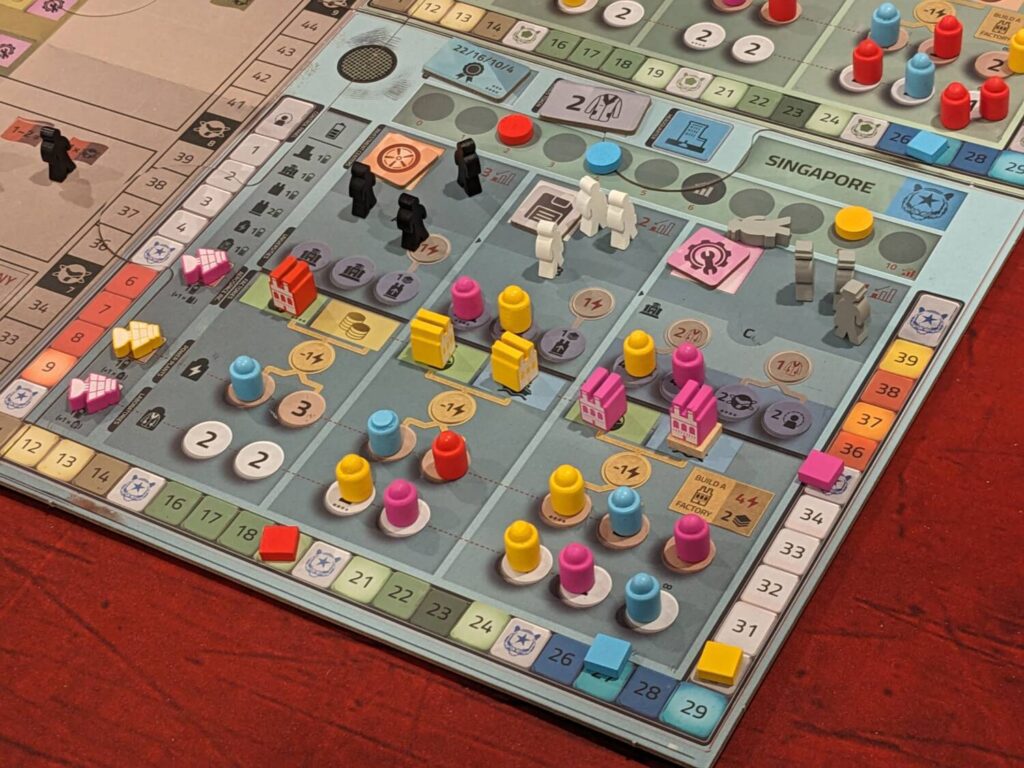
Total This, Then Total That
At the end of the game, players will look at each of the game’s four Tigers (regions) to see who had the most influence in each area. First, they’ll need to count up the value of each player’s buildings in a region. That fits. Then, depending on the Era, each player will get a boost on the influence track for that Tiger based on the number of “investment points” they have in that region. (Yes, this is separate.)
In a two-player game in the second Era, the person with the most investment points gets a 20-point bump on the influence track. Then, based on the player who is farthest ahead on the influence track after that, the leader will score a number of points based on the potential scoring for that Tiger, ranging from 12-22 points.
This gives each region a three-tier scoring mechanic: calculating investment points, then adjusting influence track, then awarding prosperity points. Calculating investment points is tied to the value of each infrastructure type in that region, boosted by a mechanic using satellites that doubles the value of a base score for any building in its row, minus parts factories
If that wasn’t enough, Asian Tigers asks the players to do this four times for the four regions. This level of scoring is intense—and not necessarily unique, since I complain about something similar every time I play one of the Brass games–but in Asian Tigers it feels a little bit like complexity for the sake of it. You definitely want to show who has the most influence in a place based on real-world concepts, and I think Asian Tigers does a decent job of that here. But it takes a solid 5-7 minutes to score the game with a full player count.
That’s just too long, in part because there are two other major scoring mechanics in addition to giving each player credit for leftover resources. Players get a big chunk of points by multiplying their place on the board’s central track that dictates turn order by the number of unique flags next to a player’s board (from their earlier sales activity), and then they can get points in up to six different ways that are also difficult to score quickly. For example, a player can score points based on the number of regions where they have a satellite. Easy. But two of the categories are more intense—the number of regions where a player has five or more different types of infrastructure already built, not including parts factories and departments, a mechanic that really could use better icons and explanations in the rulebook.
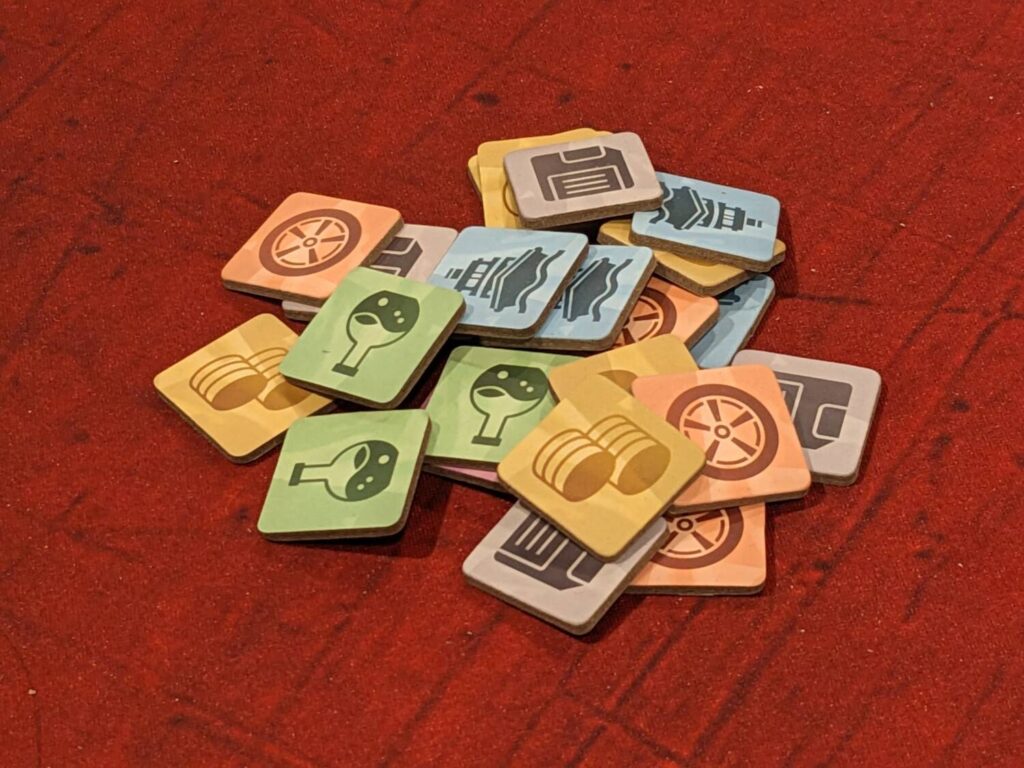
There’s a Lot to Digest Here
Here was my arc with Asian Tigers: A Story of Prosperity:
- The buzz at SPIEL was super hot for this game, so I was so excited to try it
- I spent days trying to learn the game, doing my best to stay positive while trying to figure out the mechanics
- I really enjoyed my plays, and by the third play I was certain that the worker placement mechanic is one of the best things I’ve seen all year
- I wish the game had a more elegant approach to its scoring mechanics
- I already know a second edition would shine if the game’s collective barrier to entry (rulebook, teach, production, end-game scoring) was lower. Now I’m excited to wait and see how well the game sells
If you are a fan of area control games driven by a worker placement turn mechanic, you really need to try Asian Tigers: A Story of Prosperity. It’s a flawed gem, but it’s a game I am very glad to have tried.











Add Comment